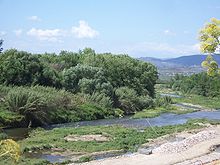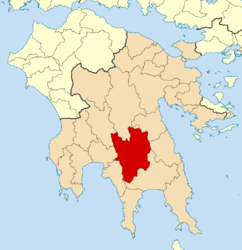|
Sparta, Laconia
Sparta (Greek: Σπάρτη, Spárti [ˈsparti]) is a city and municipality in Laconia, Peloponnese, Greece. It lies at the site of ancient Sparta within the Evrotas Valley. The municipality was merged with six nearby municipalities in 2011, for a total population (as of 2021) of 32,786, of whom 17,773 lived in the city. History  Beginning in the 13th century, the political and cultural center of Laconia shifted to Mystras, some 4 km to the west. The settlement at ancient Sparta, named Lacedaemonia, continued to exist, although greatly depopulated, until modern times as a town of a few thousand people who lived among the ruins, in the shadow of Mystras.[3] The Palaiologos family (the last Byzantine Greek imperial dynasty) also lived in Mystras. The Despotate of the Morea was captured by the Ottomans under Mehmed II in 1460. In 1834, after the Greek War of Independence, King Otto of Greece decreed the town should be expanded into a city. Modern-day Sparta, the capital of the prefecture of Lakonia, lies on the eastern foothills of Mount Taygetos in the Evrotas River valley. The city has been built upon the site of ancient Sparta, whose Acropolis lies north of the modern city.[4] To the southwest stands Mt. Taygetos. To the east of the city stands the Parnonas mountain range, which is forested predominantly with Greek fir trees and other conifers. The municipality was formed on 21 March 1835, and officially declared the Municipality of Sparta in 1845. It was transferred from Laconia to Lacedaemon Province in 1899, but this was reversed in 1909. The city hall was constructed in 1872 during the tenure of Mayor Emmanuel Meletopoulos.[1] Today Sparta maintains its good design, boasting large squares and wide streets lined with trees, while many of the older buildings remain in excellent condition. The city of Sparta is the economic, administrative and cultural center of Lakonia. A key factor in the advancement of the city's development is the operation of two departments of the University of Peloponnese and a department of the Technological Educational Institute. The centrally located main square is dominated by the most imposing neo-classical building in Sparta, the City Hall. Built in 1909, City Hall bears the signature of the Greek architect G. Katsaros.[5] During the monarchy (which was abolished by referendum in 1973), the title of Duke of Sparta was used for the Greek crown prince, the διάδοχος (diádokhos). Municipality  The municipality of Sparta was formed at the 2011 local government reform by the merger of the following seven former municipalities, that became municipal units:[6] The municipality has an area of 1,181.780 km2, the municipal unit 84.453 km2.[7] The municipal unit consists of the local communities Sparta, Afisi, Amykles, Kalyvia Sochas and Kladas.[6] PoliticsPetros Doukas, who served from 2019 to 2023, was affilated with New Democracy.[8] Michalis Vakalopoulos was elected mayor of Sparta in 2023 as a member of the Sparta Together coalition.[9]
Demographics
ClimateThe city of Sparta enjoys a sunny and warm Mediterranean climate (Köppen: Csa). January highs are around 14 °C (57 °F) while July and August highs are around 36 °C (97 °F) in the city proper. Sparta records the highest summer average maximum temperatures in Greece.[10] The highest temperature ever recorded in Sparta is 45.7 °C (114.3 °F) in August 2021.[11] On average, Sparta records 6 days per year with temperatures of over 40.0 °C (104.0 °F).[12] In June 2024, Sparta recorded an astonishing mean max temperature of 37.6 °C (99.7 °F).[13] In July 2024 the HNMS station in Sparta registered a record average maximum temperature of 38.6 °C (101.5 °F) while the NOA station registered a record of 38.5 °C (101.3 °F) [14]
TourismMain sites  In the center of the city is the Archaeological Museum. Built by architect G. Katsaros, in 1874–76 to house the collection of local archaeological finds by Panagiotis Stamatakis, it was the first Greek museum in a provincial city. The city's cathedral is at the southwest end. The ruins of ancient Sparta lie north of the city. Entering by the South Gate of the Acropolis, known as Lakedaemonia, there is the Rotunda, the Theatre and the Temple of Athena Chalkioikos to the West. Exiting the Acropolis by the North Gate there are the remains of the earliest ancient walls, the Heroon and the Altar of Lycourgos, whereas to the East there is the Sanctuary of Artemis Orthia. To the North is the Monastic Church of Osios Nikonas (10th century). The "Tomb of Leonidas", or Leonidaion (37°04′36″N 22°25′31″E / 37.0767°N 22.4254°E), is a limestone structure of the late 5th century BC, likely a temple, but named for Leonidas I in the 19th century, being the only ancient monument indicated within the limits of the newly planned town in 1834.[19] Museums
SportsThe Spartathlon has taken place every September since 1983. It is an ultramarathon starting in Athens and finishing in Sparta at the statue of Leonidas, with many international participants. The local football club of Sparta, Laconia was Sparta F.C. The club dissolved in 2019. People
Twin towns – sister cities
References
External linksWikimedia Commons has media related to Sparti.
|
|||||||||||||||||||||||||||||||||||||||||||||||||||||||||||||||||||||||||||||||||||||||||||||||||||||||||||||||||||||||||||||||||||||||||||||||||||||||||||||||||||||||||||||||||||||||||||||||||||||||||||||||||||||||||||||||||||||||||||||||||||||||||||||||||||||||||||||||||||||||||||||||||||||||||||||||||||||||||||||||||||||||||||||||||||||||||||||||||||||||||||||||||||||||||||||||||||||||||||||||||||||||||||||||||||||||||||||||||||||||||||||||||||||||||||||||||||||||









